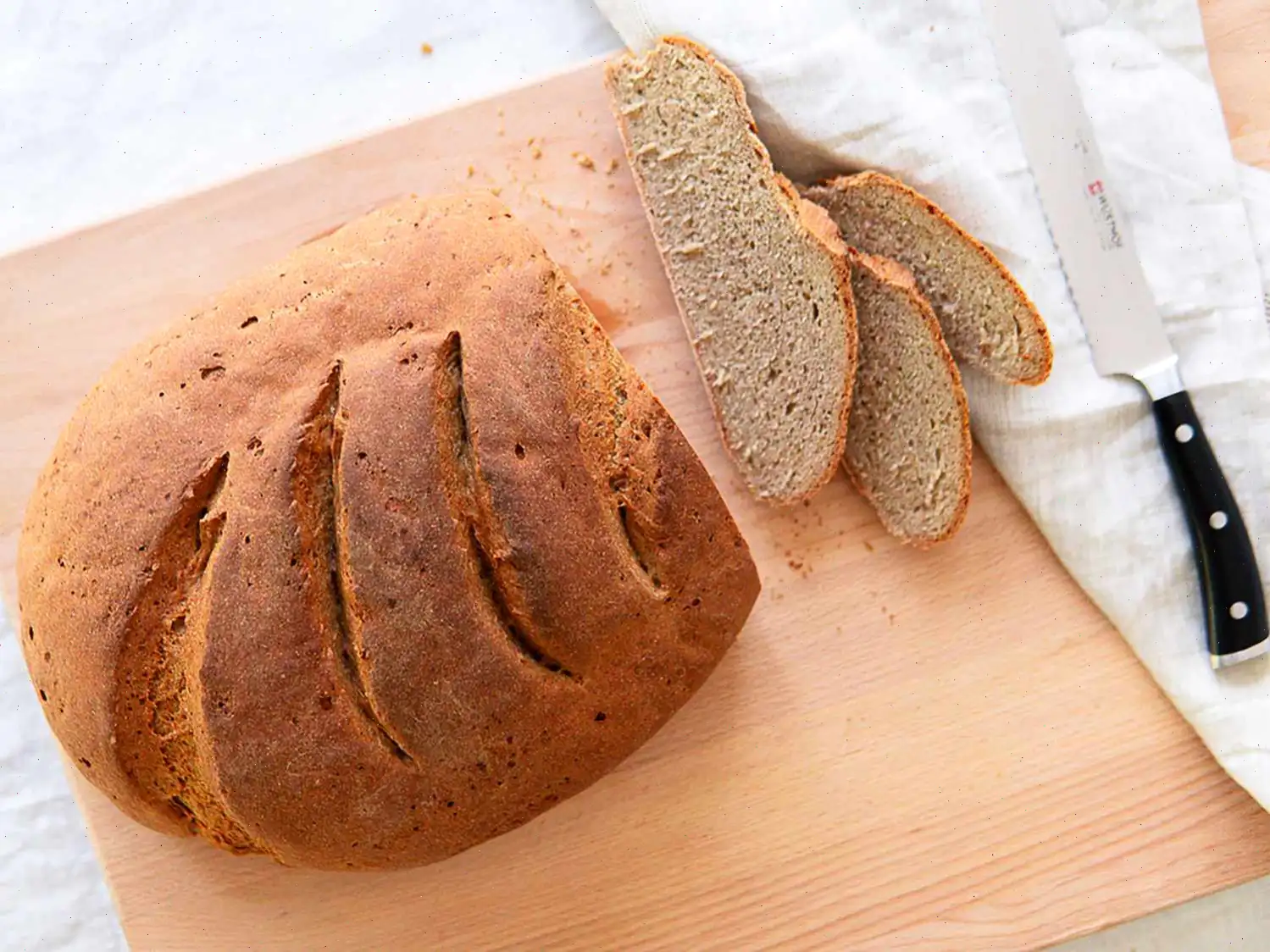
Authentic German Bread (Bauernbrot) Recipe
Ingredients
- 1 ounces compressed fresh yeast
- 1 quart warm water
- 2 tablespoons white sugar
- 8 cups all-purpose flour, divided
- 8 cups white rye flour
- 2 tablespoons salt
- 1 teaspoon white sugar
- 2 cups warm water
Directions
Step 1: Begin by making the sourdough starter. Crumble the yeast into a large bowl. Add 1 quart of warm water and 2 tablespoons of sugar. Whisk until dissolved. The water should be slightly warmer than body temperature. Gradually mix in 4 cups of flour, ensuring there are no lumps. Cover the bowl with a dish towel and let it sit at room temperature for 24 hours.
Step 2: After 24 hours, stir the mixture well, cover again, and let it stand for another 24 hours. The sourdough will be thin and light-colored, and it will be ready to use.
Step 3: In a separate large bowl, combine the rye flour, the remaining 4 cups of all-purpose flour, salt, and sugar. Add the sourdough starter to the dry ingredients, mixing with a wooden spoon. Gradually stir in 2 cups of warm water.
Step 4: Transfer the dough to a heavy-duty stand mixer to knead for the first few minutes. When the dough becomes too heavy for the mixer, turn it out onto a floured surface. A clean countertop works best for kneading. Add a few tablespoons of water at a time if the dough is too stiff. Knead the dough for 15 to 20 minutes until it becomes smooth and elastic.
Step 5: Place the dough in a large bowl, cover it, and allow it to rise until doubled in size, about 1 to 2 hours.
Step 6: Once the dough has risen, scrape it out of the bowl and onto a floured surface. Knead it for an additional 5 minutes to activate the gluten. Shape the dough into 1 or 2 long loaves.
Step 7: Place the loaves on baking sheets and let them rise for about 1 hour, or until your finger leaves an impression when gently poked into the dough.
Step 8: Preheat your oven to 425F (220C). Bake the bread for approximately 45 minutes if you made two loaves, or 1 hours for a single large loaf. Dont worry if the crust turns dark; it will add flavor, and the bread will still be delicious.
Step 9: Allow the bread to cool completely before slicing. If you like, you can freeze half of the bread to enjoy later.
Notes
If you wish to make extra starter for the next time, add 2 cups of all-purpose flour and 2 cups of water to the sourdough starter on the second day, whisking smooth. Let it stand for 24 hours at room temperature before using it again. Save half for your next batch. If you freeze the starter, use it within 2 weeks.
Humidity and heat can affect the outcome of this bread. If it's too humid or hot outside, consider making the bread early in the morning, starting at 5 a.m.
Nutrition Facts (per serving)
- Calories: 334
- Total Fat: 1g (2% Daily Value)
- Saturated Fat: 0g (1% Daily Value)
- Sodium: 702mg (31% Daily Value)
- Total Carbohydrate: 72g (26% Daily Value)
- Dietary Fiber: 8g (27% Daily Value)
- Total Sugars: 2g
- Protein: 9g (18% Daily Value)
- Calcium: 20mg (2% Daily Value)
- Iron: 3mg (18% Daily Value)
- Potassium: 206mg (4% Daily Value)
* Percent Daily Values are based on a 2,000 calorie diet. Your daily values may vary depending on your calorie needs.
FAQ about Authentic German Bread (Bauernbrot) Recipe
Comments
Elizabeth Cruz
07/23/2024 10:33:36 AM
This recipe is a fantastic starting point for making traditional German rye bread. I have used it numerous times with great success. The key is to thoroughly knead the dough, which I do using my Kitchenaid stand mixer. I let the machine run for an additional 10 minutes after the dough has come together, resulting in a final dough that is smooth but slightly sticky, not overly dry. The recipe yields a large amount of dough (3.6 kg or 8 lbs), so be mindful of your mixer's capacity if using a smaller one or consider halving the recipe for hand mixing. I prefer using dark rye flour and replacing 2 cups of water with buttermilk in the final dough for added richness. When shaping the loaves, I usually divide the dough into three portions and leave one plain, mix caraway seeds into one, and incorporate deeply caramelized onions into the third. To make the onion addition, I sauté 3 medium onions until dark golden brown, pat them dry with paper towels, and knead them into the dough along with additional white flour as needed. The result is a bread with exceptional flavor!
Gary Mitchell
03/04/2025 08:52:10 AM
Reviewed: I come from a German background and spent a significant part of my childhood there, so finding a good German bread recipe is important to me. I recently tried this Bauernbrot recipe, and it turned out to be excellent. It was surprisingly easy to make, and the end result was delicious. My mom and I were extremely pleased with how it turned out, and even my kids couldn't get enough of it. I did make a few adjustments to the recipe - I used dark rye instead of light rye as that was all I could find at the store. Although the starter I made didn't rise much, the bread itself rose perfectly during baking. The dough was a bit sticky while kneading, so I added extra flour to manage it. The loaves turned out huge, so I plan on using bread baskets for a better shape next time. I also floured and scored the top before baking on a stone, resulting in two oversized loaves. Next time, I might make three smaller loaves and add some spices and rye berries for extra flavor. Overall, a fantastic recipe that I will definitely be making again. Thank you, Petra!
Katherine Martinez
01/05/2024 10:55:45 AM
I have made this recipe multiple times and have tried it as written and with a significant modification. I would give the original recipe five out of five stars, but I also have a personal variation to share. The recipe turned out perfectly for me. For those experiencing flat results, there could be a couple of reasons. Firstly, your yeast might be inactive. Secondly, keep in mind that when the recipe mentions 1-2 hours for proofing, focus more on the dough doubling in size rather than strictly sticking to the time. It may need more time, so be patient. I used a pre-existing sourdough starter, and the initial rise in my kitchen took 18 hours. So, it's essential to wait for the dough to double rather than just relying on the suggested time frame. As for my twist, I have a sourdough starter that has been maturing for around six months. I bypassed steps 1 and 2, proceeding directly to step three and combining a quart of my established starter with the flour from that point onward. This resulted in a tangier and slightly denser loaf. Both versions of the recipe turned out well. Enjoy your baking experience!
Rebecca Walker
09/26/2023 04:47:54 AM
Started with whole wheat flour that needed more development. Switched to all-purpose flour and the results were fantastic! The loaf was small, so I'll double the recipe next time.
Janet Robinson
10/29/2022 12:04:18 PM
I started with whole wheat flour which was not fully developed, but switched to all-purpose flour and the result was fantastic! The loaf turned out small, so I plan to double the recipe next time.








